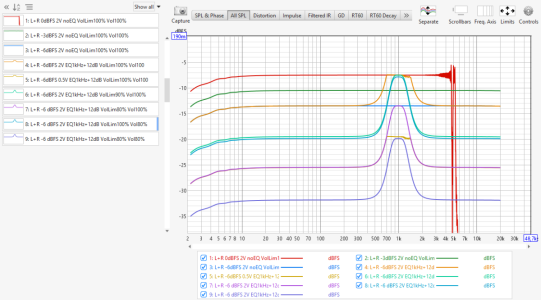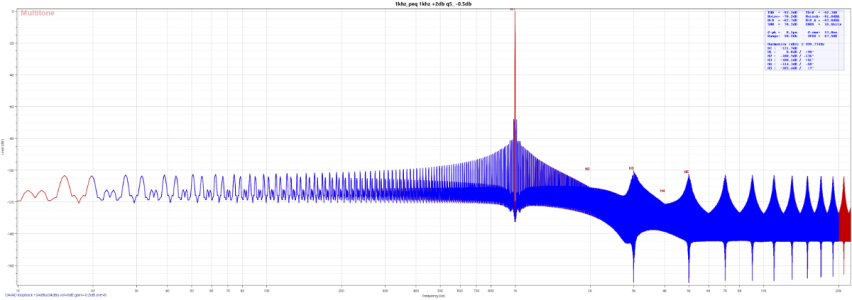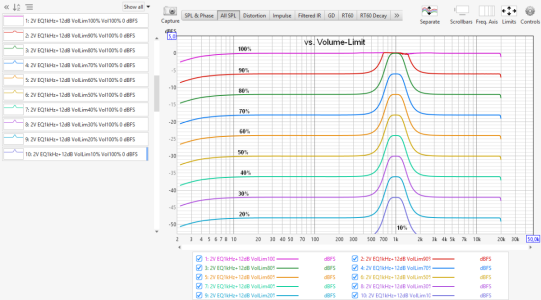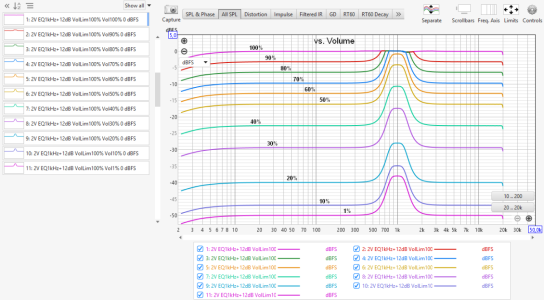IMHO it is a very reasonable compromise - average level of most content will not be near 0dBFS anyway, and it is similarly unlikely that most users would keep volume at 100%/fixed level all the time.
For the rare cases where these conditions do happen, WiiM implementation of EQ still avoids clipping by using a graceful form of limiting output, without having to decrease playback level. Even in such cases the change in tonality due to this implementation might not be very audible, since it would likely only affect waveform peaks in the content.
Have to say it is a very interesting and clever approach! I'm impressed, nice work
@WiiM Team!

I was not fully happy to see these FullScale frequency responses in
@dominikz 's post, although the implementation is very clever and clean. It avoids clipping and it doesn't lower the overall maximum level which might be a limitation in one or the other setup.
My plan is to use the WiiM Pro Plus as streaming source and as "Room-Correction-insert" in the tape-loop (record out -> Line In, Line out -> tape input) of my integrated Arcam amplifier. The analog Line-In of the WiiM allows me to route Tuner and Phono through the room-correction equalization as well as my CD-player (when connected to the Toslink input). So RC is performed on all sources.
Volume control will be done on the Arcam and I initially thought I will run the WiiM at Vol=100% and would thus have the potential level limitation shown in dominikz's post when using boosting EQ settings.
I did some measurements playing with EQ, incoming digital level, output voltage setting, Volume-Limit and Volume.
Signal chain was REW -> SMSL PO100AK -> Toslink -> WiiM Pro Plus Line out -> Cosmos Scaler+ADCiso -> REW

(1) digital 0dBFS, Vout=2Vrms, no EQ, VolLimit=100%, Vol=100%: This is the maximum output level. (I have no idea why the 0dBFS frequency response shows artifacts around 5kHz. The REW then stopped the sweep because it detected excessive distortion. I will have to look into this)
(2) digital -3dBFS, Vout=2Vrms, no EQ, VolLimit=100%, Vol=100%: 3dB down as expected
(3) digital -6dBFS, Vout=2Vrms, no EQ, VolLimit=100%, Vol=100%: 6dB down as expected
(4) digital -6dBFS, Vout=2Vrms, +12dB@1kHz, VolLimit=100%, Vol=100%: Limits level to FS as already shown by
@dominikz.
(5) digital -6dBFS, Vout=0.5Vrms, +12dB@1kHz, VolLimit=100%, Vol=100%: Limits level to FS, which is consequent if you want to reliably limit the max. output level and thus max. power.
(6) digital -6dBFS, Vout=2Vrms, +12dB@1kHz, VolLimit=90%, Vol=100%: seems to be exactly -6dB compared to 100% and together with the -6dBFS digital input level this thus allows the extreme EQ to pass without getting limited.
(7) digital -6dBFS, Vout=2Vrms, +12dB@1kHz, VolLimit=80%, Vol=100%: another 6dB down resulting in 6dB headroom as expected
(8) digital -6dBFS, Vout=2Vrms, +12dB@1kHz, VolLimit=100%, Vol=80%: about 0.5dB lower than (6)
(9) digital -6dBFS, Vout=2Vrms, +12dB@1kHz, VolLimit=80%, Vol=80%: about 6.5dB lower than (7)
Observations:
The volume slider still goes from 0% - 100% when Vol-Limit ist set below 100%. I like this approach because it allows a finer volume adjustment and it would be irritating getting stuck at e.g. 80%.
It seems like Vol-Limit and Vol scale differently but it's likely that I have accidentally changed the digital level when adding measurements (8) and (9) later on.
I now plan to limit the volume to e.g. 80 or 90% to account for the boost PEQ filters I have in my room-eq. The APO-EQ that I currently use calculates and recommends a Preamp gain of -7dB. Given the excellent AK4493SEQ based DAC in the WiiM Pro Plus I have no concern at all to attenuate a couple of dBs using "Vol-Limit" to allow for headroom for the EQ and for intersample peaks.
I assume, that in case an external DAC is used, the behavior at the digital outputs will just be the same as for the analog output. I will look into this when I find some time.








